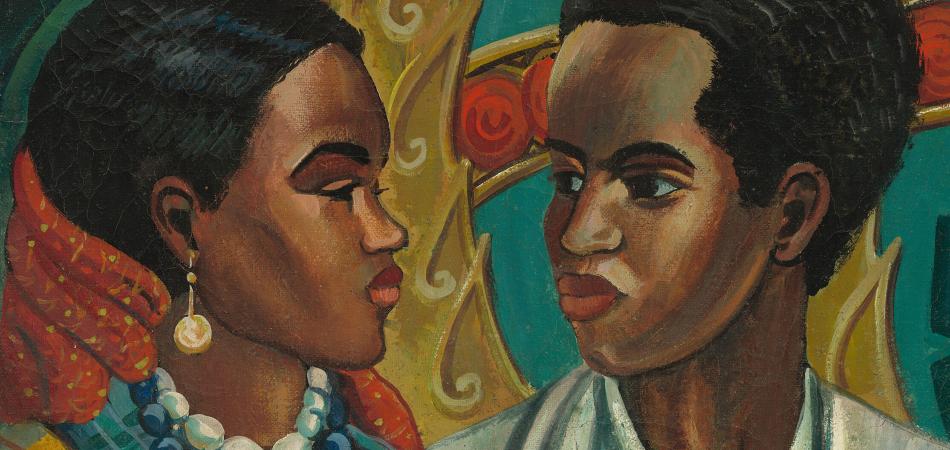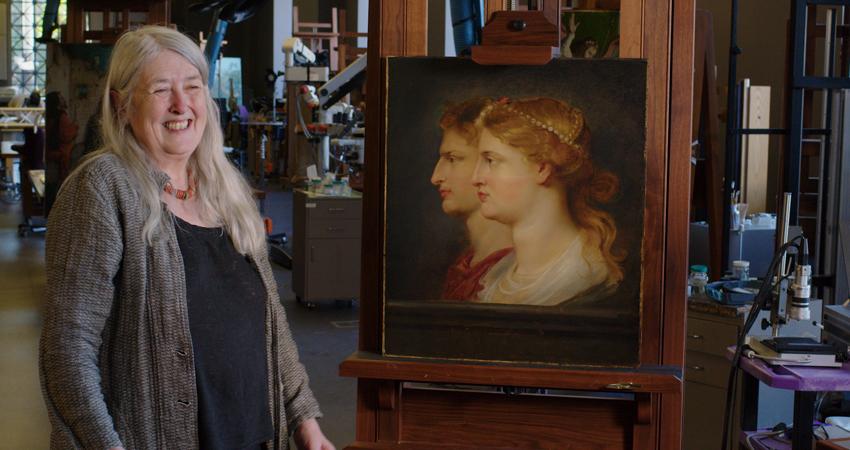Agrippina and Germanicus
c. 1614
Sir Peter Paul Rubens
Artist, Flemish, 1577 - 1640

Between 1600 and 1608, Peter Paul Rubens lived and worked in Italy, where he immersed himself in the study of ancient sculpture. He admired the idealized beauty of its classical forms and recognized its importance as a pictorial source for Greek and Roman history. While in Italy, Rubens executed numerous drawings after antique sculpture—marble and bronze, freestanding and relief—as well as antique gems, medallions, and cameos. These studies became sources of reference and inspiration for the artist, whose interest in classical antiquity continued unabated for the rest of his life.
The Gallery’s double-profile image of Agrippina (14 BC – 33 AD), the granddaughter of Emperor Augustus, and her husband, Germanicus (b. 15 BC), a prominent and highly lauded commander-in-chief in the Gallic and Germanic provinces of the Roman Empire, is one of the most vivid manifestations of Rubens’s interest in antique sculpture. Executed around 1614, it resembles a cameo in subject and composition, yet, as was Rubens’s great talent, the figures feel full of life. He subtly differentiated Agrippina’s luminous, ivory-colored flesh from the ruddy complexion of her husband, and used rhythmic touches of his brush to create accents of light that give life to her wavy golden hair.
Despite the fact that Rubens’s double-profile has pictorial roots in the overlapping profiles occasionally found in ancient cameos and coins, there is no direct pictorial source for this painting. Most ancient cameos and medals with overlapping images of male and female heads depicted the male in the foreground, but here Rubens has granted Agrippina pride of place. Technical evidence suggests that he initially intended to portray Agrippina alone, and only later extended the panel to include Germanicus. Agrippina was deeply connected to the city of Cologne, Rubens’s hometown, where she famously helped to defend a bridge in AD 14, thereby ensuring the safe return of Roman soldiers from battle. The city was, thus, named Colonia Agrippinensis (Cologne) after her daughter Agrippina the Younger. It may be that Rubens executed the painting in commemoration of her noble actions, and over the course of its evolution, those of her husband as well.
Artwork overview
-
Medium
oil on panel
-
Credit Line
-
Dimensions
overall: 66.4 × 57 cm (26 1/8 × 22 7/16 in.)
framed: 95.25 × 86 × 9.53 cm (37 1/2 × 33 7/8 × 3 3/4 in.) -
Accession Number
1963.8.1
More About this Artwork

Article: 34 Artworks About Love at the National Gallery
From first kisses to tragic romances, our collection abounds with love, in all its forms.

Video: “Agrippina and Germanicus” with Mary Beard
Scholar Mary Beard explores the story of Agrippina and Germanicus by Sir Peter Paul Rubens.
Artwork history & notes
Provenance
F. van Bredael; purchased 1710 by Prince Johann Adam Andreas of Liechtenstein [1657-1712], Vienna;[1] by descent through the Princes of Liechtenstein to Prince Franz Josef II von und zu Liechtenstein [1906-1989], Vienna, and later Vaduz, Liechstenstein;[2] purchased 25 October 1963 through (Feilchenfeldt, Zurich) by NGA.
[1] According to records from the Liechtenstein Collection in NGA curatorial files, the painting was purchased 26 August 1710 from the collection of "F. van Bredael." In the catalogue of the 1948 exhibition of works from the collection of the Princes of Liechtenstein, the name of the seller is given as Jean Pierre van Bredael, or Jan Peeter van Bredael, in Antwerp.
[2] Records from the Liechtenstein Collection in NGA curatorial files indicate that the painting, which came under export ban following the 1938 annexation of Austria by Nazi Germany, had been stored from 1940-1944 in the monastery at Gaming and then in 1945 sent to the salt mine at Lauffen bei Ischl before arriving in Vaduz, Liechtenstein, in April 1945. However, Gustav Wilhelm, the director of the Liechtenstein art collections, noted that works from the collection were sent to Gaming starting in February 1941 and that some were then sent to Lauffen starting in February 1945. See Gustav Wilhelm, The Journey of the Liechtenstein Gallery from Vienna to Vaduz, Munich, 2005:14, 48.
Associated Names
- Bredael, F. van
- Liechtenstein, Johann Adam Andreas I of Prince
- Liechtenstein, Prince Joseph Wenzel of
- Liechtenstein, Prince Anton Florian I of
- Liechtenstein, Prince Josef Johann Adam of
- Liechtenstein, Prince Johann Nepomuk Karl of
- Liechtenstein, Prince Franz Josef I of
- Liechtenstein, Alois I of Prince
- Liechtenstein, Prince Johann I of
- Liechtenstein, Prince Alois II of
- Liechtenstein, Prince Johann II of
- Liechtenstein, Prince Franz I of
- Liechtenstein, Prince Franz Josef II of
- Walter M. Feilchenfeldt
- Princes of Liechtenstein
Exhibition History
1948
Meisterwerke aus den Sammlungen des Fürsten von Lichtenstein, Kunstmuseum, Lucerne, 1948, no. 137.
1998
A Collector's Cabinet, National Gallery of Art, Washington, D.C., 1998, no. 49, fig. 21.
2008
Il cammeo Gonzaga: arti preziose alla corte di Mantova, Fruttiere di Palazzo Te, Mantua, 2008-2009, no. 85, repro.
2013
L'Europe de Rubens, Musée du Louvre-Lens, 2013, no. 79, repro.
2015
From Rubens to the Grand Tour, Academy Art Museum, Easton, Maryland, 2015, unnumbered catalogue, fig. I.
2018
Peter Paul Rubens and the Birth of Baroque, The National Museum of Western Art, Tokyo, 2018-2019, no. 7, repro.
2023
Il tocco di Pigmalione: Rubens e la scultura a Roma [The touch of Pygmalion. Rubens and sculpture in Rome], Museo Galleria di Villa Borghese, Rome, 2023 - 2024, VI.1, repro.
Bibliography
1965
Summary Catalogue of European Paintings and Sculpture. National Gallery of Art, Washington, 1965: 118.
1968
National Gallery of Art. European Paintings and Sculpture, Illustrations. Washington, 1968: 106, repro.
1970
Jaffé, Michael. "Some Recent Acquisitions of Seventeenth-Century Flemish Painting." Studies in the History of Ar 1969 3 (1970): 20-23, fig. 23.
1975
European Paintings: An Illustrated Summary Catalogue. National Gallery of Art, Washington, 1975: 314, repro.
1984
Walker, John. National Gallery of Art, Washington. Rev. ed. New York, 1984: 252, no. 321, color repro.
1985
European Paintings: An Illustrated Catalogue. National Gallery of Art, Washington, 1985: 361, repro.
2004
Kräfter, Johann, Wilfried Seipel and Renate Trnek. Rubens in Vienna. The Masterpieces. Vienna, 2004: 18, repro.
2005
Wheelock, Arthur K., Jr. Flemish Paintings of the Seventeenth Century. The Collections of the National Gallery of Art Systematic Catalogue. Washington, D.C., 2005: 160-166, color repro.
Van Wagenberg-Ter Hoeven, Anke A. "A Matter of Mistaken Identity. In Search of a New Title for Rubens's Tiberius and Agrippina." Artibus et historiae 26, no. 52 (2005): 113-127, fig. 1.
2020
Libby, Alexandra. “From Personal Treasures to Public Gifts: The Flemish Painting Collection at the National Gallery of Art.” In America and the Art of Flanders: Collecting Paintings by Rubens, Van Dyck, and their Circles, edited by Esmée Quodbach. The Frick Collection Studies in the History of Art Collecting in America 5. University Park, 2020: 139.
2021
Wheelock, Arthur K., Jr. "In Pursuit of Masterpieces: The National Gallery of Art’s Acquisitions from the Prince of Liechtenstein." Artibus et historiae 42, no. 83 (2021): 322, 324, color fig. 15, 325, 328, 330 n. 41.
Inscriptions
lower left, an inventory number: 19
Wikidata ID
Q20176933

